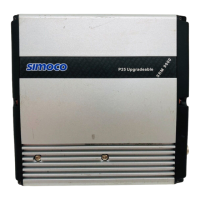DRAFT D
TNM-M-E-0001 Page 15
3.1.3 Quadrature Demodulator
Additional IF gain of approximately 30dB occurs at U401 which is a dedicated IF AGC
amplifier/Quadrature Demodulator configured for single ended input and output operation. The
AGC voltage for U401 is derived from the RSSI function of the DSP via AUX CTL and
multiplexer U902. The onset of AGC operation occurs when RF input signal levels at the
antenna exceed -90dBm.
Conversion of the 45MHz IF signal to I and Q baseband signals is carried out by the
demodulator section of U401. The 90MHz local oscillator signal is generated by VCO Q402
which is phase locked by the auxiliary PLL output of U701 via feedback signal AUX LO2.
3.1.4 Receiver Audio Processing
All receiver audio processing and filtering functions are performed by the CODEC U800 under
the control of the DSP. The receiver I and Q analog baseband signals are converted to digital
signals by the CODEC ADC before being applied to a series of digital filters which provide the
final stage of adjacent channel filtering, high pass and low pass filtering and mute noise
processing for narrow and wideband operation. The processed signals are then converted to
analog audio signals by the CODEC DAC and are applied to conventional audio amplifiers
U803A/B and the speaker amplifier U5.
There are two speaker options available. A half bridged configuration using a speaker across
balanced output SPKR OUT1 and 2 which provides an audio output level of up to 4 watts into 4
ohms. The other option is a full bridge configuration using a high power speaker across SPKR
OUT1 and 2 and providing an audio output level of up to 10 watts into 8 ohms. The carrier and
signalling mute functions are performed by Q810/811/813 under DSP control with additional
receiver muting to U803B being applied by U103C when the mobile is in transmit mode. De-
emphasis to the audio PA U5 is performed by R43 and capacitors C42 to C58. Flat audio is
provided to S1-6 via amplifier U803A.
3.2 Transmitter
Refer Figure 3-2.
3.2.1 Drivers and PA Stages
The RF output level from the VCO buffer Q604 is typically +5dBm (UHF) and +8dBm (VHF). TX
buffer Q606 increases this level by approximately 3dB (UHF) and 11dB (VHF) and also provides
additional VCO isolation. The following section of the TX buffer Q612 is controlled by the
transmitter power control loop and Q609. Q609 is normally saturated in transmit mode so there
is no minimum gain control applied to this stage. The gain of Q612 is typically 10dB (UHF) and
15dB (VHF) but the output level is reduced by input and output resistive attenuators to limit the
PA driver input level to typically +20dBm. The gain of PA driver Q12 is controlled by the power
control loop to ensure that transmitter output power remains within defined limits. The PA driver
output level is typically +25dBm. PA module U2 utilises three stages (UHF) and two stages
(VHF) to achieve the required final RF output power level of +44dBm (25 watts). Power output
settings are derived from alignment data stored in flash memory during the initial factory
alignment. The DSP processes this data to optimise the power output level relative to the
programmed channel frequencies which may be changed at any time without retuning the radio.
.

